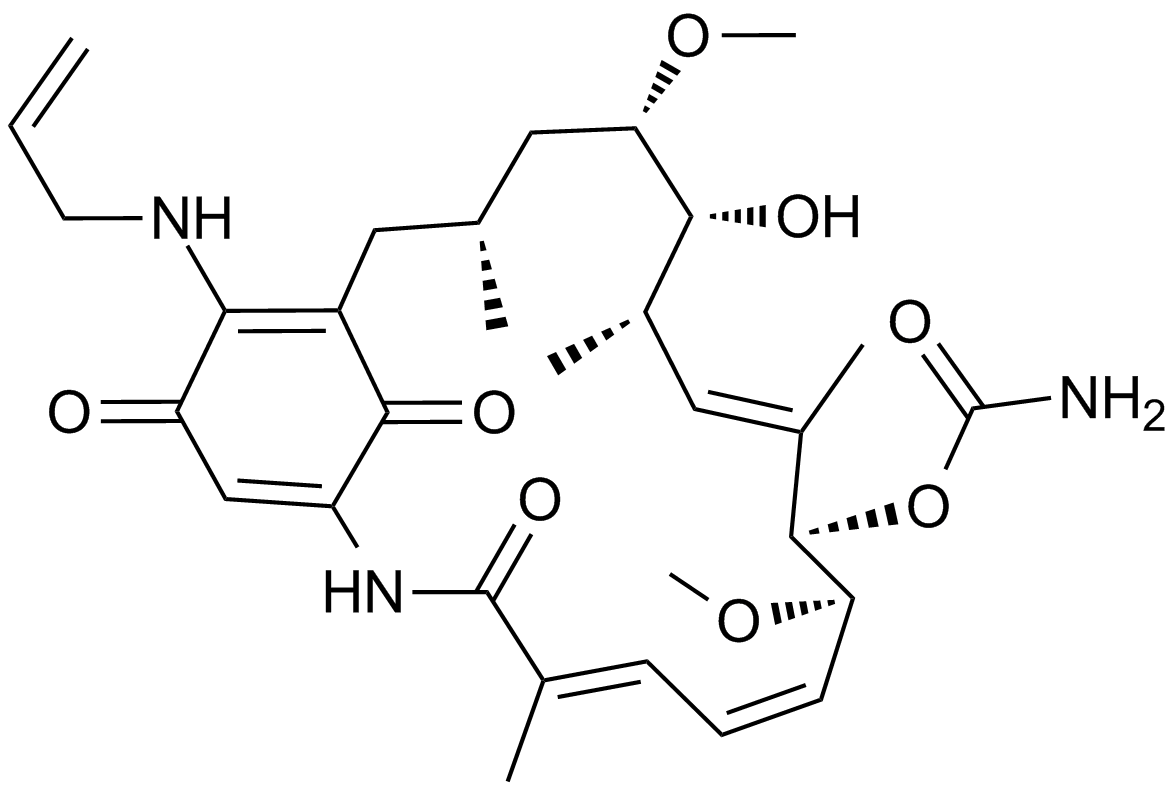17-AAG (KOS953) (Synonyms: BMS 722782, CP 127374, KOS 953, NSC 330507, Tanespimycin) |
| Catalog No.GC11720 |
An inhibitor of Hsp90
Products are for research use only. Not for human use. We do not sell to patients.

Cas No.: 75747-14-7
Sample solution is provided at 25 µL, 10mM.
17-AAG(Geldanamycin), a natural benzoquinone ansamycin antibiotic, is the first established inhibitor of Hsp90. It inhibits Hsp90's ATPase function through binding to its amino-terminal domain[5].
17-AAG as a potent HSP90 inhibitor with an IC50 value of 6 nM in BT474 cells, inhibited the binding of HSP90 to HIF-1α[2]. In a concentration- and time-dependent manner, inhibition of Hsp90 by 17-AAG decreased Akt and eNOS expression. Inhibition of eNOS expression by 17-AAG occurred at the transcriptional level. Furthermore, treatment with 17-AAG decreased basal and vascular endothelial growth factor-stimulated Akt and eNOS phosphorylation. This corresponded with decreased NO production and inhibition of endothelial cell migration and angiogenesis[3].17AAG topically applied to mouse skin, inhibits UVR-induced development of cutaneous squamous cell carcinoma (SCC) [7].
Therapeutic potential of 17-AAG was investigated using nude mice intraperitoneal xenograft. A combination of 17-AAG and DDP could inhibit tumor growth more efficiently, The survival time of the mice was significantly prolonged, supporting the notion that 17-AAG combined with DDP could prolong the survival time of mice[1].17-AAG is able to inhibit the growth of both human glioma cell lines and glioma stem cells in vitro . In addition, 17-AAG can inhibit the growth of intracranial tumors and can synergize with radiation both in tissue culture and in intracranial tumors. This compound was not found to synergize with temozolomide in any of our models of gliomas[6].17-AAG plus trastuzumab is well tolerated and has antitumor activity in patients with HER-2+ breast cancer whose tumors have progressed during treatment with trastuzumab. These data suggest that Hsp90 function can be inhibited in vivo to a degree sufficient to cause inhibition of tumor growth[4].
References:
[1]: Wang Y, Chen Q, et,al. Lamin-A interacting protein Hsp90 is required for DNA damage repair and chemoresistance of ovarian cancer cells. Cell Death Dis. 2021 Aug 12;12(8):786. doi: 10.1038/s41419-021-04074-z. PMID: 34381017; PMCID: PMC8358027.
[2]: Kamal A, Thao L, et,al. A high-affinity conformation of Hsp90 confers tumour selectivity on Hsp90 inhibitors. Nature. 2003 Sep 25;425(6956):407-10. doi: 10.1038/nature01913. PMID: 14508491.
[3]: Sun J, Liao JK. Induction of angiogenesis by heat shock protein 90 mediated by protein kinase Akt and endothelial nitric oxide synthase. Arterioscler Thromb Vasc Biol. 2004 Dec;24(12):2238-44. doi: 10.1161/01.ATV.0000147894.22300.4c. Epub 2004 Oct 14. PMID: 15486309; PMCID: PMC2633590.
[4]: Modi S, Stopeck AT, et,al. Combination of trastuzumab and tanespimycin (17-AAG, KOS-953) is safe and active in trastuzumab-refractory HER-2 overexpressing breast cancer: a phase I dose-escalation study. J Clin Oncol. 2007 Dec 1;25(34):5410-7. doi: 10.1200/JCO.2007.11.7960. PMID: 18048823.
[5]: Neckers L, Schulte TW, et,al. Geldanamycin as a potential anti-cancer agent: its molecular target and biochemical activity. Invest New Drugs. 1999;17(4):361-73. doi: 10.1023/a:1006382320697. PMID: 10759403.
[6]: Sauvageot CM, Weatherbee JL, et,al. Efficacy of the HSP90 inhibitor 17-AAG in human glioma cell lines and tumorigenic glioma stem cells. Neuro Oncol. 2009 Apr;11(2):109-21. doi: 10.1215/15228517-2008-060. Epub 2008 Aug 5. PMID: 18682579; PMCID: PMC2718982.
[7]: Singh A, Singh A, et,al. Topically applied Hsp90 inhibitor 17AAG inhibits UVR-induced cutaneous squamous cell carcinomas. J Invest Dermatol. 2015 Apr;135(4):1098-1107. doi: 10.1038/jid.2014.460. Epub 2014 Oct 22. PMID: 25337691; PMCID: PMC4366283.
Average Rating: 5 (Based on Reviews and 30 reference(s) in Google Scholar.)
GLPBIO products are for RESEARCH USE ONLY. Please make sure your review or question is research based.
Required fields are marked with *




















